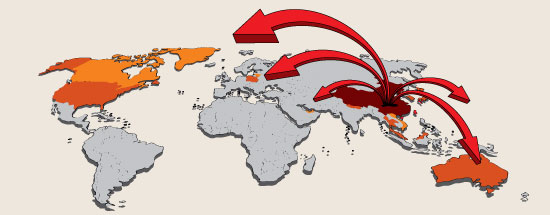
Stopping the spread of Coronavirus |

Coronavirus has been making headlines since the outbreak was first reported in China's Wuhan city in December 2019. With countries around the world stepping up their efforts to tackle the new virus, we spoke to NSW Health Pathology’s infectious disease specialist and medical virologist, Professor William Rawlinson to learn more.
Coronaviruses are a large family of viruses found in both animals and humans. Some of these viruses infect people and are known to cause illness ranging from the common cold to more severe diseases such as Middle East Respiratory Syndrome (MERS) and Severe Acute Respiratory Syndrome (SARS). Novel coronavirus (SARS-CoV-2) is a new strain of coronavirus that has not been previously identified in humans. The new, or “novel” coronavirus, now officially called SARS-CoV-2, causing the illness known as COVID-19 (Coronavirus Disease, 2019), had not previously been detected before this current outbreak was reported[1].
“What is concerning is that this is a new virus and we do not know what changes the virus may undergo. So far, we have seen that COVID-19 spreads like a respiratory virus and is almost certainly spread from animals. We know that the virus can also be spread from human-to-human, and this ability has been key to further transmission of infection. Since this particular coronavirus has some different characteristics to viruses our immune system has encountered before, it is able to cause more generalised and, in this case, more severe infections than we usually see with this type of virus,” said Prof Rawlinson.
Given that emergence of COVID-19 was so recent, the understanding of transmission patterns, severity, clinical features and risk factors for infection remains limited[2]. The most recent situation report released by the World Health Organisation (26 February 2020) shows that the virus has been confirmed in 37 countries outside China[3]. Reducing transmission of virus has therefore been an important factor in tackling the outbreak.
“It is very important to reduce transmission of the virus. If you can delay the spread of the outbreak, then the virus tends to fall in numbers. The best way to do this is by preventing travel, by avoiding contact with high risk groups at any given time, and by controlling movement of cruise ships and aircraft between countries. We have had a small number of cases here in Australia – 23 so far – and the public health control intervention has been very effective in preventing the spread. We are finding that people are being very responsible – which is very positive – and we all need to continue to do so,” said Prof Rawlinson.
Human-to-human transmission is believed to occur mainly through droplets and symptoms range from a mild cough and a runny nose to pneumonia. There is currently no treatment for COVID-19 and a small number of the total of infected people get sick very quickly. Whilst this is the case and there have been a number of deaths reported, it is important to note that most people do recover easily.
“We believe there are a lot of people who have been infected with COVID-19 and are recovering. We are hoping that the overall mortality rate will be lower than the 2% that we think currently. To give some comparison, the mortality rate for the SARS outbreak was around 9%. Those people who are experiencing symptoms, especially those who have had appropriate exposure, either having been to China or having been in contact with someone who has had the COVID-19 infection, should get tested.”
“If someone thinks they are at any risk then they should call their GP and put themselves into self-isolation until testing and appropriate discussion with their Doctor. The public health unit would be notified, and the individual can be tested for complications such as pneumonia which is the major complication we are seeing currently. The patient would be monitored, and their test would need to be negative before they are able to come out of isolation. Testing is taking place at appropriate labs throughout Australia and New Zealand and is likely to become more widely available over the coming months,” said Prof Rawlinson.
If anyone is concerned that they may have contracted coronavirus, they should call the Coronavirus Health Information Line on 1800 020 080 or 0800 358 5453 (New Zealand) for more information on how to proceed.
You are welcome to circulate this article to your contacts, share it on your social media platforms and forward it to any relevant contributors and experts for them to share and post on their websites. If you do reproduce this article in any such fashion you must include the following credit:
This article appeared in the December 2020 Edition of ePathWay which is an online magazine produced by the Royal College of Pathologists of Australasia (http://www.rcpa.edu.au/Library/Publications/ePathway).
« Back to Home Page


| 